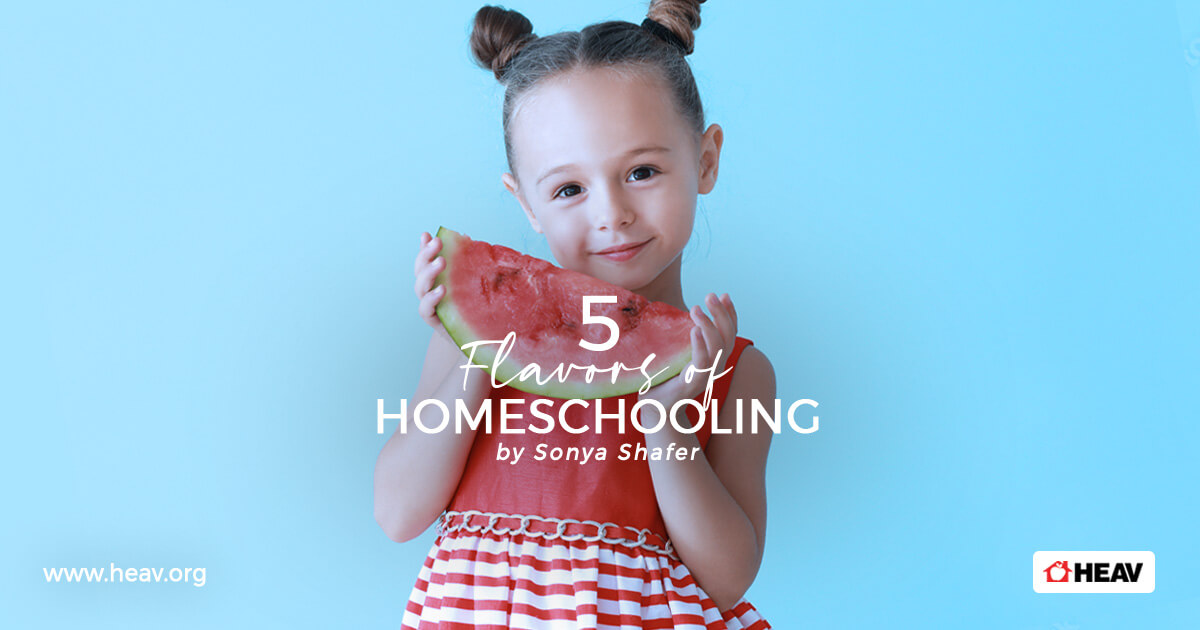Learning Styles
Don’t you love to look through recipe websites? I just found a great recipe app for my computer. Now any time I see a recipe I like, I can click and drag it into that app, and it magically transfers all the information to my collection of recipes.
That’s the easy part. The hard part is looking through page after page of mouth-watering photographs and recipes and deciding what to serve my family.
You know, the more I talk to homeschoolers around the country, the more I’m convinced that the world of homeschooling is a lot like the world of food–and there are many flavors of homeschooling. There are so many possibilities for what educational food can look and taste like, it can get overwhelming. Let’s simplify the options.
Flavors of Homeschooling
In the food world, there are many different flavors—Italian, Mexican, Chinese, or American dishes, to name a few. In homeschooling there are also many “flavors.” You might prefer traditional, classical, Charlotte Mason, unit studies, or unschooling. What’s the difference? Here’s a quick overview of the flavors of homeschooling.
Traditional Homeschooling is probably similar to what you grew up with in the classroom. It usually involves textbooks and workbooks for various subjects. You read the assigned chapter in the textbook and answer questions about the content. Usually the workbooks contain fill- in-the-blank and multiple-choice questions.
Classical is another flavor. Classical homeschooling is based on teaching children in three stages, called the Trivium. The Grammar Stage (ages six to ten) focuses on absorbing information and memorizing the rules of phonics, spelling, grammar, foreign language, history, science, math, etc. The Dialectic Stage (ages ten to twelve) emphasizes logical discussion, debate, drawing correct conclusions, algebra, thesis writing, and determining the whys behind the information. The rhetoric Stage (ages thirteen to eighteen) continues the systematic, rigorous studies and seeks to develop a clear, forceful, persuasive use of language.
Charlotte Mason is the third type. This approach to homeschooling uses rich literature and “living books” rather than textbooks. Charlotte was a British educator in the late 1800s and early 1900s who emphasized respecting each child as a person and giving him a broad education. This flavor of homeschooling includes nature study, art and music appreciation, and handicrafts, as well as the usual academic subjects. It seeks to “spread a feast” before the child and let him digest what is appropriate for him at the time. And it uses methods that will nurture a love for learn-ing and reinforce good lifelong habits; it does not just present a body of information.
Unit Studies, the fourth option, takes a theme or topic and incorporates all the school subjects into that topic. For example, when you study Ancient Egypt, you read books about Egypt (history), make a salt dough map of Egypt (geography), determine how to calculate the height of a pyramid (math), explore how Egyptians irrigated their farm- land from the Nile (science), read a historical fiction book set in Ancient Egypt (literature), build sugar cube pyramids (art), and learn how to spell “pyramid” (language arts).
Unschooling can go by many names, but it basically follows the interests of the child. There is no set curriculum. If a child is interested in butterflies, you research and learn about them until the child is satisfied. If he develops an interest in race cars, you give him information on race cars.
Planning The Menu
Do any of those flavor descriptions whet your appetite? Just as you can find restaurants and stores that cater to each food cuisine, you will find publishers that cater to each flavor of homeschooling. And those publishers will be gathered at your annual homeschool convention. Think of the convention as a “Taste-of-Homeschooling” event. You will be able to learn more about each flavor of homeschooling and take a closer look at different publishers’ materials.
Shopping for curriculum and materials is a lot like shopping for a meal. You can buy a ready-made meal to go, like pizza. Some publishers offer that: all subjects in a grade are packaged for you—sort of like third grade in a box. The publisher gives you everything to do for that child for that year. Ready-made school- in-a-box is convenient but not customized.
An alternative to ready-made is shopping for different components of your meal. Instead of getting a pizza to go, you might shop around for ingredients for a crust, sauce, and toppings to make your own customized pizza. It’s the same with homeschool materials. You have freedom to choose components from various publishers and put them all together.
It’s not as convenient as school-in-a-box and might take more time to plan or prepare, but you can customize for each child.
Making Adjustments
Whatever flavor you choose, make sure it is one that you enjoy and works well for your family during this season of life. The key is to teach the child, not just teach the curriculum.
Feel free to tweak the spices in the sauce or change the toppings you use as you go along. One of the great things about homeschooling is the freedom you have to make changes as needed. If you’re not enjoying something or discover that it’s not your child’s taste, make adjustments. Swap out an ingredient.
Trying a different flavor might seem a bit scary at first, but give it some time and gain a little experience, and you will settle into your favorite flavor of homeschooling. Soon you will find that you are navigating the homeschool world with ease.
If you’re interested in this flavor of homeschooling go to www.simplycharlottemason.com.
This article was originally published in the 2016 summer edition of the Virginia Home Educator.










